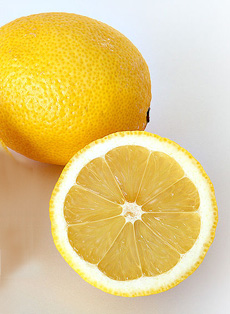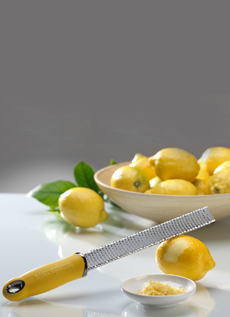TIP OF THE DAY: Frozen Lemons & Lemon Zest
|
Last month we discussed the different uses for lemon juice.
Today we’ll tackle another delicious part of the lemon: lemon zest, the grated rind of the lemon. The rind is the top layer or skin of the peel; the peel also includes some of the white pith under the skin. How to make lemon zest? Simply hold a washed, dried lemon in one hand and run a zester over it with the other (we use a Microplane lemon zester in the photo, which comes in a variety of handle colors and is a fun party favor for Mother’s Day). Zest lightly: You only want the yellow rind, not the white pith underneath it. If you don’t have a zester, you can use any kind of grater. Here‘s an easy way to have fresh zest on hand all the time: Just freeze a whole washed lemon in a plastic bag. |
|
|
|
You can zest the frozen peel a bit at a time, as you need it, and toss or sprinkle it on top of your foods. When all the zest is gone, keep the lemon frozen until you need fresh lemon juice. Then, let it defrost, and juice away. Freshly grated zest can make just about anything taste better. Take out the lemon and the zester as you serve: |
||
 The slender zest provides intense flavor. Photo by Andre Karwath | Wikimedia. |
ABOUT THE LEMON
The lemon tree, which has the botanical name Citrus limon, is a small evergreen. The fruit is used for primarily for its juice, though the pulp and zest are also used, mainly in cooking and baking. The tart taste of the lemon juice comes from citric acid, which comprises about 5% of a true lemon. There are many different types of lemons; but the components of all lemons include: |
|
|
|
||
